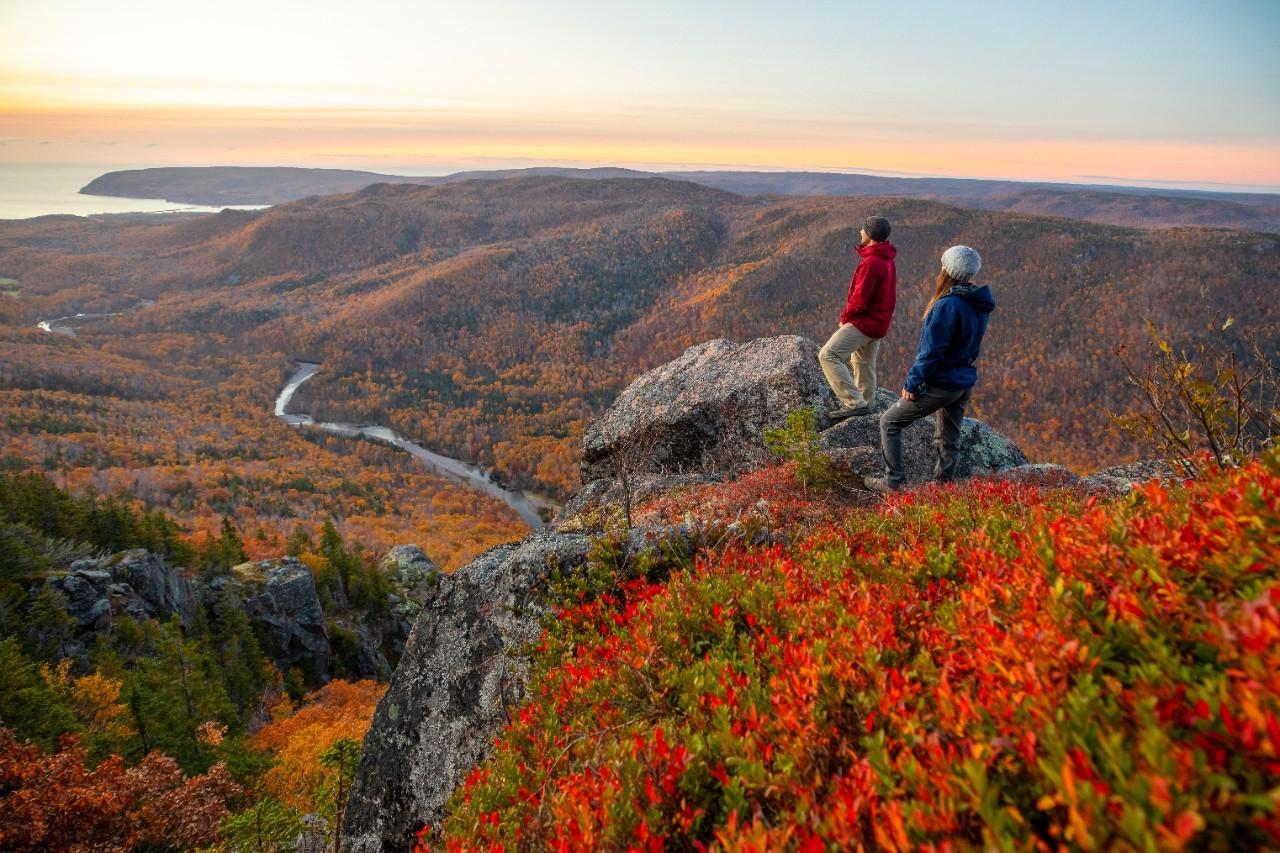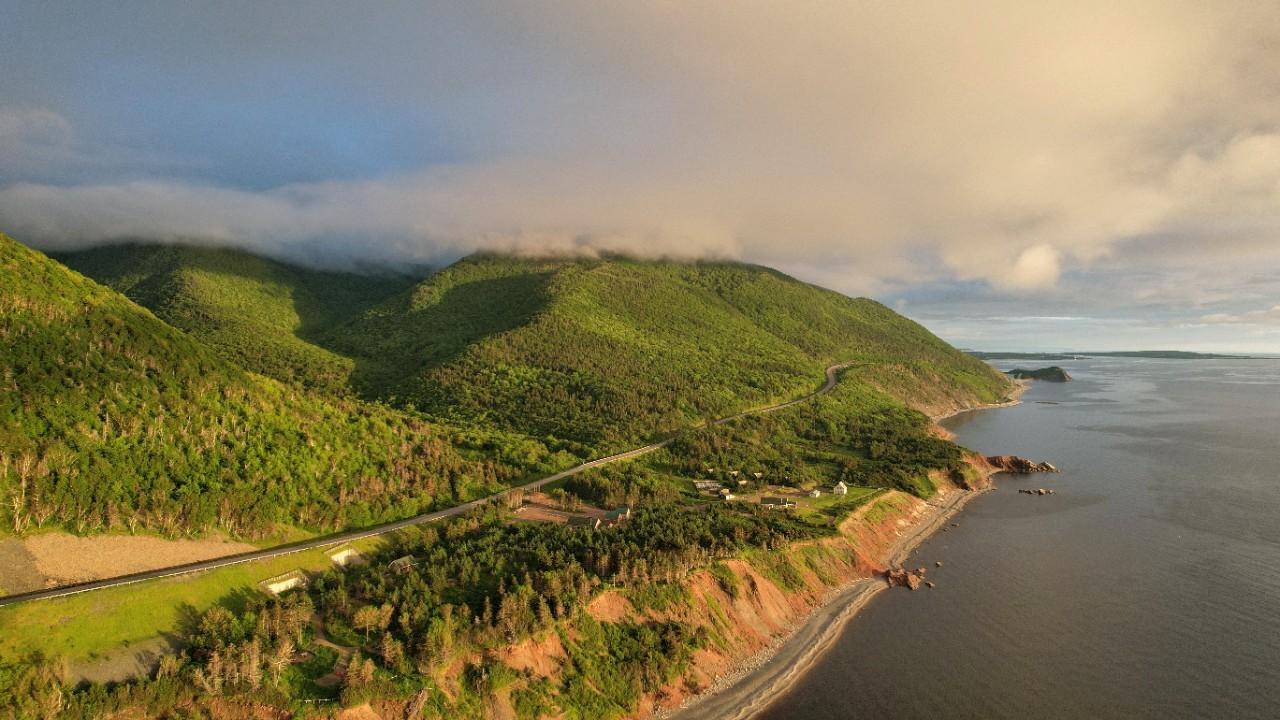
Two visitors enjoy a scenic viewpoint during the fall hiking season on the Franey Trail in Cape Breton Highlands National Park in Nova Scotia/Parks Canada, Adam Hill
Parks Canada is working towards sharing management of Cape Breton Highlands National Park with the Mi'kmaq, who consider the Nova Scotia park a place of cultural and spiritual significance.
The goal was outlined in a new management plan that will guide the next decade.
“The plan seeks to increase opportunities for the Mi’kmaq to connect with the park, have a presence in the park, practice rights-based activities in the park, and have an increased role in its shared management,” Parks Canada said in a news release. “Increased Mi’kmaw-led heritage interpretation programming, events, celebrations, and opportunities for economic benefit are outlined, as is working toward a shared management structure in the spirit and intent of ongoing rights implementation negotiations.”
The park is in Unama’ki, a district of Mi’kma’ki, the unceded and traditional territory of the L’nu’k, now known as the Mi’kmaq.
About a five-hour drive from Halifax and a two-hour drive from Sydney, Cape Breton Highlands is best known for hiking, camping and cultural experiences and offers dramatic coastal views from the world-famous Cabot Trail that encircles the park.
Established in 1936, Cape Breton Highlands was the first national park in Atlantic Canada, and the largest national park in the Maritimes. It protects a representative example of the Maritime Acadian Highlands Natural Region, its rugged coastlines, Acadian and boreal forests, and several rare or endangered species.
The park welcomes about 300,000 visitors per year, with one-third of those visitors coming from outside of Canada. Of the Canadian visitors, two-thirds visit from outside of the Atlantic region. It’s an important tourism icon and economic driver in a largely rural, resource-dependent economy.

An aerial view of the new Mkwesaqtuk/Cap-Rouge Campground and the Cabot Trail on the western side of Cape Breton Highlands National Park/Parks Canada, Adam Hill
The new management plan replaces the previous one from 2010.
It notes that the Mi’kmaq helped many waves of European immigrants to Cape Breton Island adapt to their new home. Cultural resources in the park reflect this wide breadth of history, including Indigenous sites, and remnants of the settlements of Acadians, Scottish, Irish, French, Basque, Portuguese and others.
With tourism a growing industry in the early 1900s, there was pressure on the provincial government to improve and complete a travel circuit around the northern area of Cape Breton. Constructed in the 1920s, the Cabot Trail is a world-renowned scenic highway that provides striking vistas of the coastline and the highlands. One-third of the Cabot Trail runs through the park, and it remains the only transportation route linking communities in northern Cape Breton.
Along the Cabot Trail there are many pulls-offs with stunning views and interpretive signage, including new trilingual signage with information in Mi’kmaq, French and English.
There is a growing relationship with the Mi’kmaq of Nova Scotia, particularly with respect to collaborative ecosystem management and monitoring, and visitor programming. Over the past six years, the park has worked closely with the Unama’ki Institute of Natural Resources on resource management issues of mutual interest, including moose management, forest management and use, and the management of aquatic ecosystems.
Some targets that Parks Canada has identified:
• Rights-based use of the park by the Mi’kmaq, including culturally significant harvesting activities, increases over the next five years.
• The number of events and celebrations held by the Mi’kmaq in the park increases over the next 10 years from the 2019 baseline.
• The number of participants in youth and Elder camps held in the park increases by 30 percent over the next decade from the 2019 baseline.
• By 2025, the number of Mi’kmaw businesses providing services within the park, including in collaboration with Parks Canada, increases.
• Parks Canada and the Mi’kmaq of Nova Scotia explore the possibility of introducing a Mi’kmaw name for the park within the life of the plan.
• Mi’kmaw content in visitor programs and materials increases, in collaboration with Mi’kmaw knowledge holders, from the 2019 baseline within the life of the plan.
• Informed in collaboration with the Mi’kmaq, Mi’kmaw terms and place names are increasingly incorporated into park programming, products and signage, where possible, from the 2019 baseline in the next five years.
• Within the life of the plan, the park continues to serve as a place for education and reconciliation between Mi’kmaq and Cape Breton’s other cultural communities.



Add comment